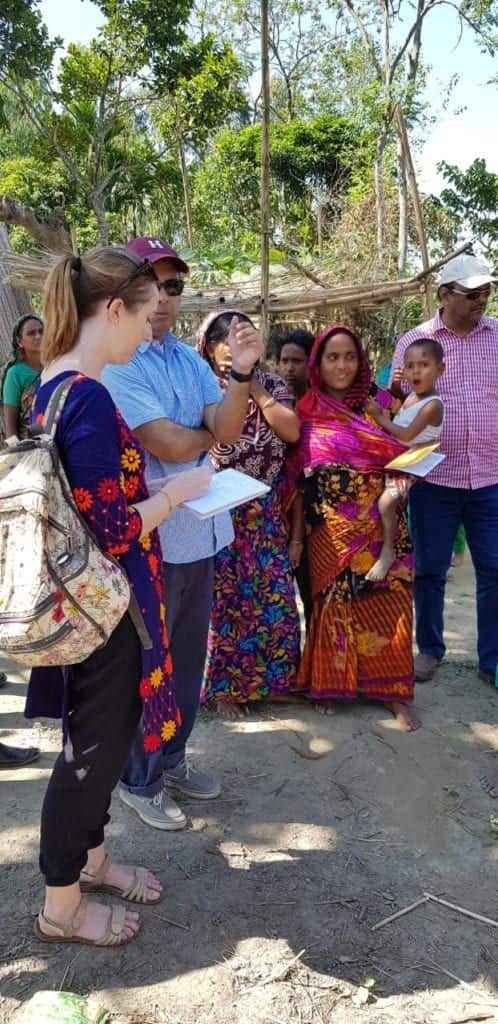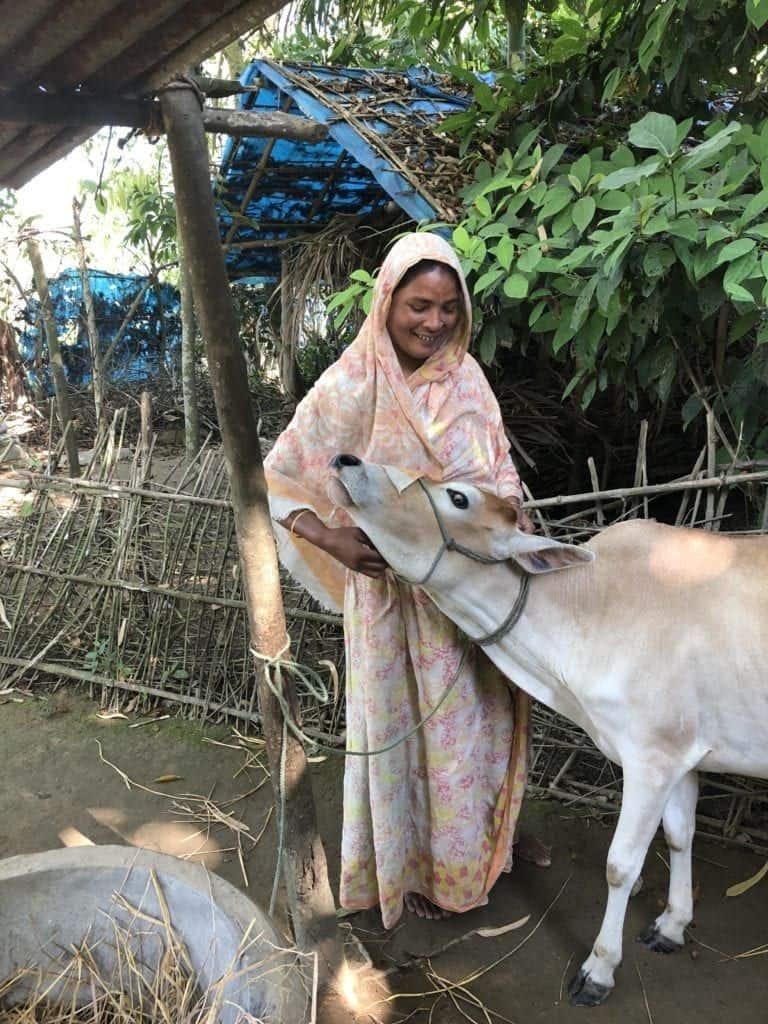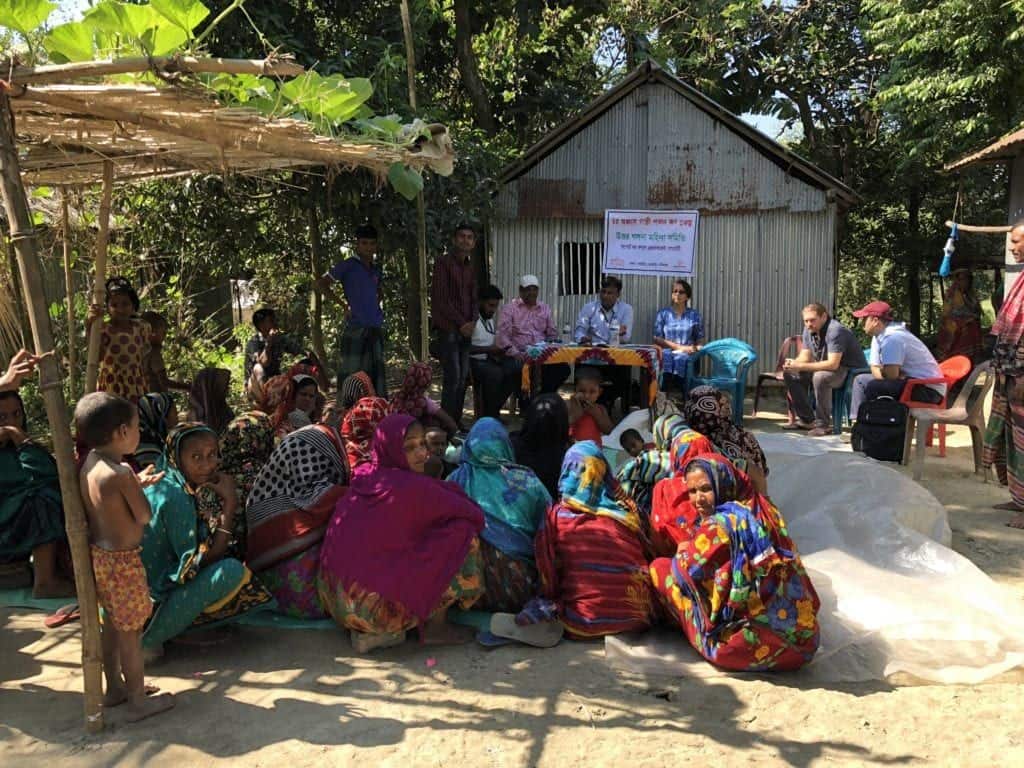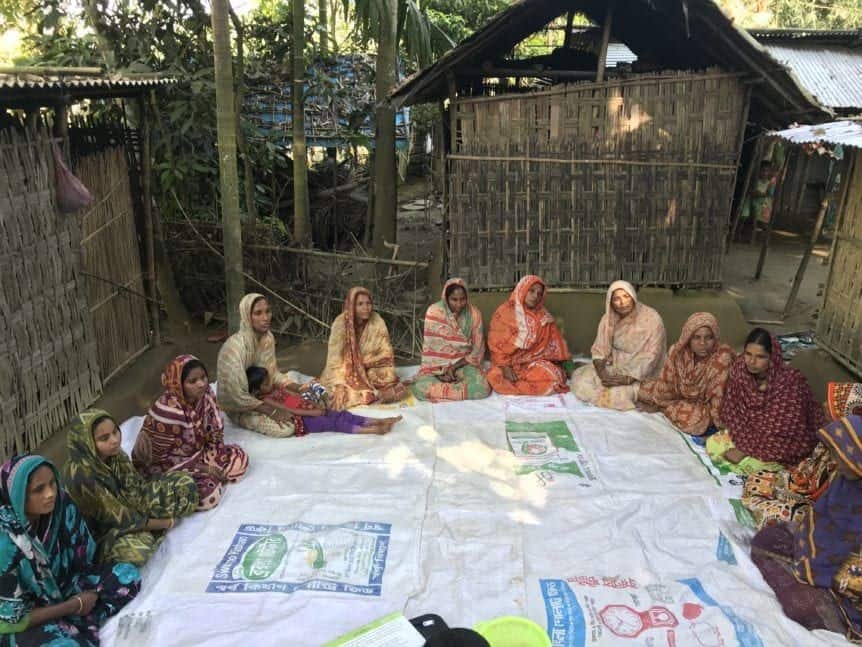Spotlight on WPF’s Bold, New Partnerships

WPF’s Claire Kelly (left) visits a center meeting in Bangladesh.
According to Women’s World Banking, “Women in Bangladesh have the highest-ever rates of literacy and employment, and the country’s economy is growing. Financial inclusion now stands at more than 50 percent, nearly doubling in the past few years. But the financial inclusion gender gap is growing rapidly too, with fewer than half of women accessing or using formal financial services.”
This is a surprising trend from the country widely considered to be the birthplace of microfinance. While the sector is characterized by many nationally scaled financing programs, many have not innovated product offerings in response to client, especially women clients’ needs. While the Women’s World Banking article highlights opportunities for further behavioral research to answer these questions, WPF can spotlight two new Bangladesh partnerships started last year which provide adapted products and services for women and likewise stretch the borders or traditional microfinance.
BRAC’s Ultra-Poor Graduation Programme
The first is BRAC’s Ultra-Poor Graduation (UPG) programme (previously known as Targeting the Ultra Poor (TUP) Programme. While WPF’s microfinance partners typically use various targeting methods to identify low income people to join their program, a microloan is not suitable for somebody who is very poor, or ultra-poor. A microloan needs to be invested in an income-generating project so that the borrower can generate increased profits and be able to pay back the loan and interest. However, an ultra-poor individual has immediate needs for basics such as food and shelter that would likely divert microloan funds from business investment. Also, the ultra-poor individual may lack self-confidence about their repayment capacity.
UPG is a comprehensive, time-bound, integrated and sequenced set of interventions that includes a high value asset package or capital of grant and/or interest free loan, enterprise development training, hands-on coaching, matched savings, healthcare services and community mobilization support that aims to enable ultra-poor households to achieve key milestones towards sustainable livelihoods and socioeconomic resilience, and progress along a pathway out of extreme poverty.

Sujata is a microcredit client of BRAC in Bangladesh.
WPF has supported four such Graduation projects to date in our global portfolio. With BRAC-UPG, WPF funds were dedicated towards the grant component of the business asset for these participants. At BRAC-UPG three types of assets (livestock, agriculture and non-farm enterprise) are provided to the participants. These typically have a purchase price of maximum 20,000 Taka ($237 USD). For example, the most popular asset is a dairy cow and for the most vulnerable group, half of these funds are provided as grant while the other half is given as an interest-free loan to be repaid by the participant. Less vulnerable participants receive smaller grant amounts and repay a larger portion and different enterprise selections also have different loan/grant breakdowns.
At BRAC-UPG, participants must complete a minimum of five mandatory criteria and get at least 7 out of 10 points for other criteria to graduate and 95% of the participants graduate from the program within the two-year period. Participants are also better linked with financial services. All participants open a savings account and practice regular savings with a local group called a Village Organization (VO). Furthermore, many participants take a microfinance loan after the two-year UPG intervention.
“Credit-Plus” Lending with SUPPORT
While UPG brings those below the microfinance entry point into the financial inclusion ladder, WPF’s other new partner in Bangladesh has an innovation for businesses that have successfully grown from the microenterprise stage to the small enterprise stage. WPF partners directly with microfinance partner SUPPORT to finance their loan portfolio in two branches in the northern regions’ Char areas. SUPPORT has partnered with Oxfam to offer financing to women who have participated in their dairy enterprise training and market linkage program. The microloan is used to finance a high yield milch cow, which will produce more milk, and when linked with the forward market systems such as chilling centers and processing plants, the borrowers get access to formal buyers as well. SUPPORT will finance these women-led dairy enterprises up to 50,000 Taka (≈$590) which goes towards the purchase of a crossbreed (higher quality) cow. The borrowers we visited already had 1 or 2 local-breed cows, but with the training and increased market linkage options provided together with the financing from SUPPORT, the clients invested in the higher quality crossbreed cows. These crossbreed cows produce milk up to 4x what a local-breed produces, so there are many opportunities to substantially grow their businesses. Once a client has four cows, she can consider a different loan product to install a bio-digester for a more environmentally friendly, healthier cooking and energy option.

Whole Planet Foundation visits a meeting of SUPPORT staff and clients.
While the dairy value chain partnership leverages several market actors to bring up the level of these microfinance borrowers, SUPPORT has another innovation. They are a member of an umbrella organization called theSTEPs.org (“STEPs”). SUPPORT MFI builds their branches together with other STEPs’ members, in moving from a microcredit branch to a Financial Inclusion Center (FIC). SUPPORT MFI clients come to the FICs for a host of services, e.g. for loan disbursements, bank accounts, technical assistance, financial literacy trainings etc. SUPPORT registers the borrowers on the i-SME platform of STEPs partner organization, Bangladesh SME Corporation Limited (BSCL). The i-SME platform prompts Field Officers to ask customers detailed questions about their overall business activities, revenues, assets, inventory, profit margins etc. in an informal way. Staff use the i-SME tool to input client information, which then builds a financial profile of the enterprise along with a credit score. Time-series data is subsequently captured over the tenor of the loan as the business and repayment history is built and recorded – the borrower is then able to leverage this credit history in the future to qualify for a bank loan application through an Agent Bank (also located within the FICs). This is a significant step towards longer term sustainability, because the bank loans are less expensive than microfinance loans. However, often clients with higher capacity and capital needs stay within the microfinance sector because banks lack the outreach infrastructure for a credit assessment. The innovative i-SME platform extends financial inclusion by helping the under-served micro borrowers to graduate from microfinance to access larger capital at cheaper rates.
In addition to leveraging Oxfam’s dairy value chain capacity building and BSCL’s investor-investee matchmaking platform (the i-SME), SUPPORT has another client-centric feature. Financial Inclusion Centers provide “tele-medicine” services to the beneficiaries, which is an opportunity for clients (especially women) to connect via a video portal with a qualified female doctor based in the capital city of Dhaka. The patients are able to access high quality medical advice without travel time and expense. A personalized prescription is automatically printed out at the end of the session to purchase any required medicines from a pharmacy.
Layering financial services with livelihood assistance and community-building services such as healthcare and business counseling is an innovative approach by both BRAC UPG and SUPPORT. Often referred to as credit-plus microfinance, this approach is a typical characteristic across WPF’s global portfolio.

